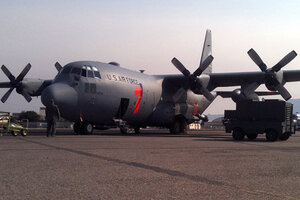Key part of firefighting fleet grounded after fatal S.D. C-130 crash
The decision by the military to put seven C-130s on an indefinite 'operational hold' has removed critical firefighting aircraft from the skies during one of the busiest and most destructive wildfire seasons ever to hit the West.

In this July 2, 2011 photo provided by the North Carolina National Guard, a crew prepares a C-130 MAFFS 7 (Modular Airborne FireFighting System) cargo plane to battle a wildfire, in Albuquerque, New Mexico.
Michael Wilber/North Carolina Air National Guard/AP/File
COLORADO SPRINGS, Colorado
Air Force air tankers fighting wildfires across the nation were grounded as investigators looked into what caused the deadly crash of a military cargo plane fighting a South Dakota blaze over the weekend.
The decision by the military to put seven C-130s on an indefinite "operational hold" has removed critical firefighting aircraft from the skies during one of the busiest and most destructive wildfire seasons ever to hit the West.
That left 14 federally contracted heavy tankers in use until investigators gain a better understanding of what caused the crash.
"You've basically lopped off eight air tankers immediately from your inventory, and that's going to make it tougher to fight wildfires," said Mike Archer, who distributes a daily newsletter of wildfire news.
"And who knows how long the planes will be down?" he said, adding that investigators will take time to make their conclusions.
The C-130 from an Air National Guard wing based in Charlotte, N.C., was carrying a crew of six and fighting a 6.5-square-mile blaze in the Black Hills of South Dakota when it crashed Sunday, killing at least two crew members and injuring others.
South Dakota Gov. Dennis Daugaard announced Tuesday that two people had died in the crash. He didn't identify either victim.
The crash cut the number of large air tankers fighting this summer's outbreak of wildfires by one-third.
President Barack Obama signed a bill last month hastening the addition of seven large tanker planes to the nation's rundown aerial firefighting fleet, at a cost of $24 million, but the first planes won't be available until mid-August.
C-130 air tankers have crashed on firefighting duty before. In 2002, a privately owned civilian version of an older-model C-130 crashed in California, killing three crew members. The plane broke up in flight and an investigation blamed fatigue cracks in the wings.
The crash, in part, prompted a review of the airworthiness of large U.S. air tankers and led ultimately to a greatly reduced fleet of large civilian tanker planes. The 44 planes in the fleet a decade ago has dwindled to nine being flown on U.S. Forest Service exclusive use contracts right now.
Another aerial firefighting plane, the Lockheed P2V, has had some problems in recent months. One crashed in Utah, killing the two pilots, and another one crash-landed in Nevada.
A military spokesman said he did not know when the grounded planes would resume firefighting flights. They were used to fight fires in Colorado, Wyoming, Montana and South Dakota.
The C-130s can be loaded with a device called the Modular Airborne Firefighting System, or MAFFS. The system can drop 3,000 gallons of water or fire retardant within seconds through a modified side door toward the rear of the plane.
The military planes had been filling up with fire retardant and flying out of Peterson Air Force Base in Colorado Springs.
The U.S. Forest Service, which owns the MAFFS devices and coordinates the program with the military, expressed support for the decision to stand down the MAFFS.
However, as a result, the Forest Service now will have to prioritize fires and the resources allocated to fight them, said Jennifer Jones, a Forest Service spokeswoman at the National Interagency Fire Center in Boise, Idaho.
Fires threatening human life will be a top priority, followed by those threatening communities and community infrastructure, other types of property, and finally natural and cultural resources, she said.
Firefighters in the field also will adjust their strategy and tactics based on the availability of air tankers.
The plane that crashed was fighting a fire about 80 miles southwest of Rapid City, S.D. The terrain of the crash site is "very, very rugged, straight up and straight down cliffs," said Frank Maynard, the Fall River County emergency management director.
Military officials have declined to discuss details of the crash, but they have said there were some crew members who were being treated for serious injuries at a hospital in Rapid City.
The family of Lt. Col. Paul Mikeal of Mooresville, N.C., said they were told early Monday that he had died in the crash. They said he was a 42-year-old married father of two and a veteran of deployments to Iraq and Afghanistan.
"There were lives lost," Lt. Col. Robert Carver of the North Carolina National Guard said at a news conference. "We are very grateful for the survivors and our thoughts and prayers and hearts go out to the families that have lost loved ones."
Among the major fires burning in the West:
— Colorado: The 28-square-mile Waldo Canyon Fire was 70 percent contained. The fire northwest of Colorado Springs killed two people and destroyed nearly 350 homes.
— Utah: Two new wildfires broke out on National Forest lands, one caused by target shooting, authorities said. In southern Utah, evacuations were ordered as the 500-acre Shingle fire threatened about 100 cabins.
— Montana: The 290-square mile Ash Creek fire jumped a state highway early Monday, triggering evacuations.
— Wyoming: Three large forest fires continued to spread as crews faced erratic winds and explosive fuel conditions.


